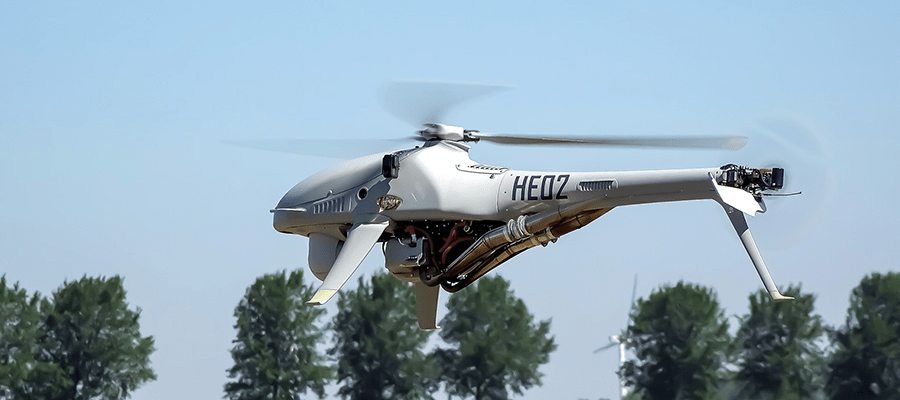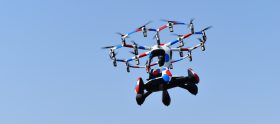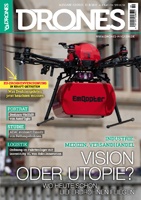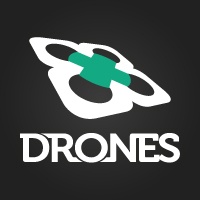Unmanned helicopter „Airboxer“ with Volz’ servos unrivaled in the market
What matters most in aviation, thus also for unmanned aerial vehicles, is reliability. The German actuator manufacturer Volz Servos and customer High Eye from the Netherlands closely cooperated to overcome challenges and found a solution for High Eye unmanned helicopter “Airboxer”. Ultimately, a standard Volz actuator with special custom-made adaptions led to “the most reliable concept that High Eye has ever created”, as CTO Marijn van de Ruit confidently reports.

Airboxer designed to safely operate in challenging environments
High Eye designed the Airboxer VTOL UAV to get in and out of locations which are out of reach for other systems to collect valuable data or transports goods up to a payload of 7 kilograms. The NATO STANAG 4738 compliant platform can be adapted to a variety of mission requirements or applications. It can be integrated in challenging environments with ease. The heavy-fuel (Jet A-1) driven UAV enablesseamless ship integration into a ship’s combat system as well as a command vehicle. As an important part of the aircraft, the Volz actuators enable the reliable and safe steering of the unmanned helicopter.
“If anything can be said about helicopters, it is that they can definitely be the summum of complexity from the perspective of the designer”, says van de Ruit, who was a commercial airline pilot before joining High Eye. “Every part of the construction requires careful evaluation to at least create an expected level of reliability.” To ensure this reliability, one safe way is through redundancy.
With Volz Servos, High Eye continued to follow the path of redundancy – with the consequence of creating extra complexity. “But the numbers don’t lie: The amount of nonrecoverable incidents has never been lower”, says Marijn van de Ruit.
The heart of the Airboxer helicopter is a complex flight control system, which requires actuators to stabilize and provide motion to the rotor systems. To provide the complex system with a reliable arrangement of actuators ensuring full redundancy is no task to be solved on a daily basis in the market. Additionally, the Airboxer is designed to safely operate in very challenging environments – if arctic areas, deserts, over the sea or also in urban areas. Therefore, the helicopter needs actuators that withstand high vibration levels, heat, moisture, impacts and rapidly oscillating control inputs.
Reliability through resilient actuators
“The current solution we created with the Volz Servos is the most reliable concept that High Eye has ever created and is unrivalled in the market”, CTO van de Ruit is convinced. “It uses the most reliable and robust actuators on the market.”
The solution, the Volz Servos experts created with High Eye is based solely on the standard Volz DA 15-N actuator line. Five DA 15 N-ISS servos ensure reliable and safe control of the swashplate below the rotor on the Airboxer. In this way, the servos realize the attack angle of the rotor blades and the direction of flight of the helicopter. The DA 15-N actuators are part of Volz’s standard range and were originally developed, for example, to withstand impacts to the control surfaces during net landings without functional impairment or damage. „The brushless motor and the ISS gear protection system with slip clutch make the servo by far the most robust of this size on the market,“ explains Volker Hammen, Head of Development at Volz. „When shocks or strong vibrations occur, the drive slips from a certain torque and thus prevents the gearbox from being damaged.“
Reliability through redundancy
To ensure redundancy, Volz and High Eye decided to install five DA 15-N-ISS to the swashplate – as three fixed contact points are defining a flat surface, two of the actuators could fail theoretically and the helicopter still remains safely controllable. „Ultimately, we were able to solve the challenges with High Eye’s Airboxer, the high mechanical loads on the actuators, with one of our Servos from the standard range,“ says Volz CEO Phillipp Volz. „We then adapted and designed, for example, the different cable lengths exactly according to customer requirements.“
“A single actuator failure is almost unheard of considering the types that have been chosen – but even in the case of a mechanical or electrical failure, the flight control system continues to behave normally and allows the safe recovery of the helicopter”, CTO Marijn van de Ruit sums it up.
Foto: High Eye
Im Drones PR-Portal erscheinen Nachrichten und Meldungen von Unternehmen aus der Drone-Economy. Für die Inhalte der Pressemitteilungen sind die jeweiligen Unternehmen verantwortlich.











